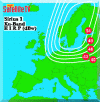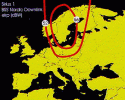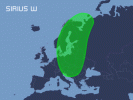SIRIUS W
SIRIUS 1 was the pioneer in the SIRIUS programme. It joined the first Nordic satellite, Tele-X, at 5E East geostationary orbit.
SIRIUS W History
The British company BSB launched it in 1989 under the name Marco Polo 1. At the end of 1993, NSAB bought the satellite and moved it to 5°East. Renamed SIRIUS 1, it started operations in 1994. The DTH services on SIRIUS 1 were transferred to SIRIUS 3 at the beginning of 2000 and SIRIUS 1 was successfully moved to the orbital position 13° West.
In order to emphasise the new orbital position, it was renamed again, this time as SIRIUS W.The orbital repositioning started on 11 April when on-board thrusters increased the speed of the satellite. This took the satellite to a new orbit, well above the 36,000-km orbit normal for geostationary satellites. The satellite slowly and safely drifted towards the new position with a speed of approximately one degree/day.
On 30 April, the satellite reached its new position and the speed was decreased by thrusters under the control of the satellite station in Esrange in the north of Sweden. SIRIUS W had five high-power DBS transponders. In order to save fuel, the satellite was operated in an "inclined orbit", requiring ground stations with satellite tracking for communication with the satellite. SIRIUS W was used for Internet Backbone services in Eastern Europe.
SIRIUS W Facts
Orbital position: 13.0°W
Coverage: Nordic countries and parts of eastern Europe
Type: HS 376, spin stabilized
Mass in orbit: 660 kg (1453 lb)
Dimension Body: 2.162 x 7.25 m
Launched: 27 August, 1989
End of life: May 2003
Operational lifetime: 10 years (> 13 years for inclined orbit operation)
Transponders: 5 BSS
Frequency band: 11.7-12.5 GHz
Transponder bandwidth: 27 MHz
Polarization: Right hand circular
EIRP: 56-59 dBW
In May 2003 SIRIUS W was sent to its graveyard orbit.





